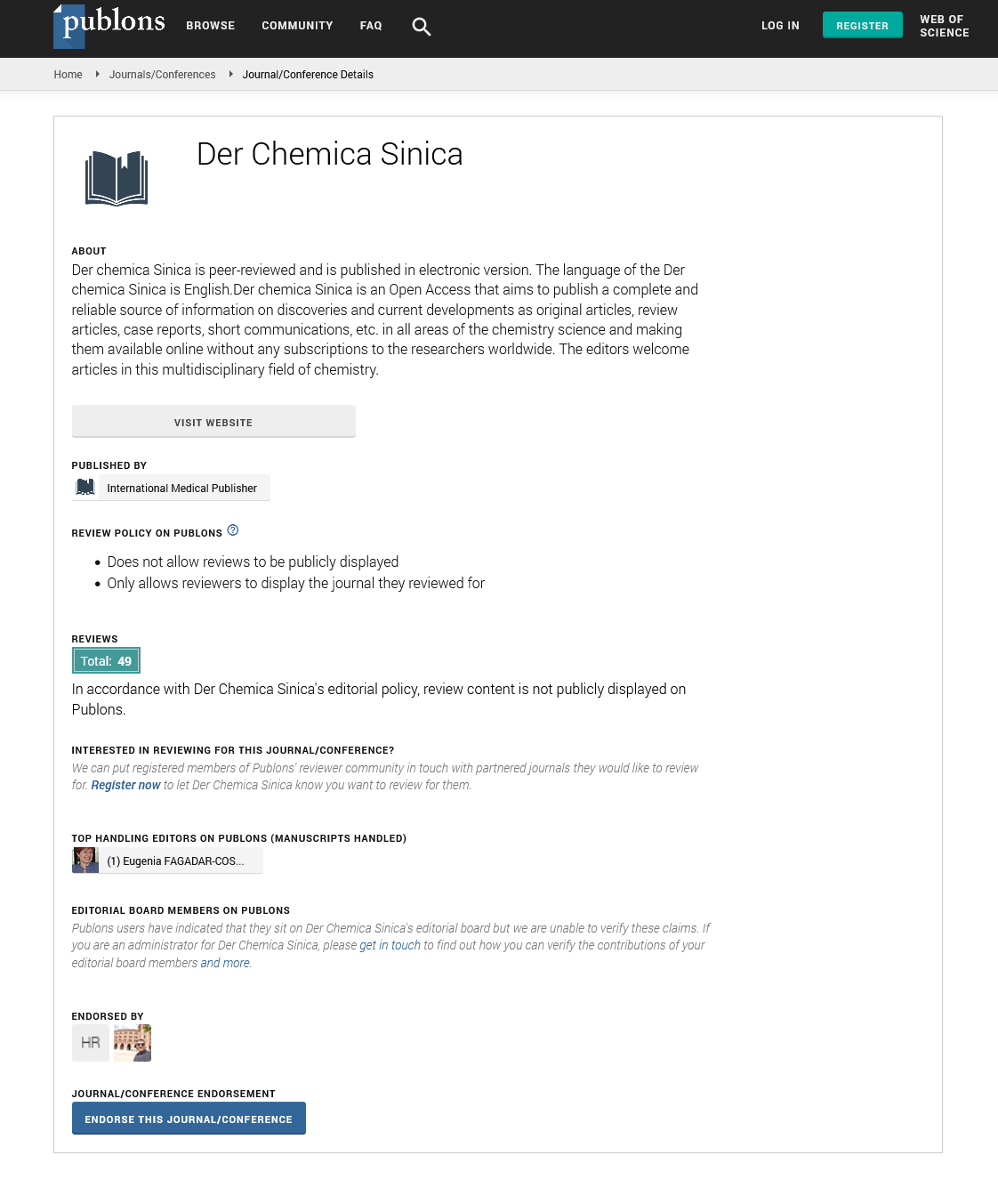ISSN : 0976-8505
Der Chemica Sinica
Abstract
Mononuclear copper (II) macrocyclic complexes derived from malonanilic carbohydrazone and thiosemicarbazide: Synthesis, spectral characterization and biological evaluation
A series of six Cu (II) complexes were prepared from N4 substituted thiosemicarbazones having structures [Cu (p-clbhtsc)2 ]Cl2. 2H2O [1], [Cu (p-mbhtsc)2]Cl2.2H2O [2], [Cu (p-nbhtsc)2]Cl2.2H2O [3], [Cu (p-clacehtsc)2 ]Cl2. 2H2O [4], [Cu (pmacehtsc) 2]Cl2.2H2O [5] and [Cu (p-nacehtsc)2]Cl2.2H2O [6] where (p-clbhtsc)=p-chlorobenzylidene thiosemicarbazone, (pmbhtsc)= p-methoxy benzylidene thiosemicarbazone, (p-nbhtsc)=p-nitro benzylidene thiosemicarbazone, (p-clacehtsc)=pchloroacetophenone thiosemicarbazone, (p-macehtsc)=p-methoxyacetophenone thiosemicarbazone, and (p-nacehtsc)=pnitroacetophenone thiosemicarbazone. All six complexes were characterized by elemental analysis, IR, 1HNMR, mass and electronic spectra. The magnetic moments and electronic spectral studies suggested distorted octahedral geometry for all the complexes. The monoanionic thiosemicarbazonate ligands act in a tridentate mode, binding through azomethine nitrogen and sulfur atom. Cytotoxic activity against human breast cancer cell line MCF-7, antibacterial and antioxidant activities were evaluated for all the six complexes. Out of the six Cu (II) complexes, five showed significant activity against the studied cell line; having IC50 values in the range 2-12 μM. The standard antibreast cancer drug Tamoxifen was used as a positive control. The synthesized compounds were screened for their in vitro antibacterial activity using Disc Diffusion method against two strains each of gram negative and gram positive bacteria. Tetracycline was used as positive control in the test. All the compounds showed significant antibacterial activity in the range of 2-10 mg/ml. Antioxidant activity of the six macrocyclic copper complexes was screened using the H2O2 scavenging assay. All six complexes exhibited potent antioxidant activity in the range 35-58%. The compounds would be evaluated further for their possible DNA binding, cleavage, antifungal and anti-diabetic activities.
Author(s): Brajraj Sharma, Rumana Ahmad, Richa Kothari, Jyoti Kushwaha, Deepti Mukhraiya and Anil K. Balapure
Abstract | PDF
Share This Article
Google Scholar citation report
Citations : 6019
Der Chemica Sinica received 6019 citations as per Google Scholar report
Der Chemica Sinica peer review process verified at publons
Abstracted/Indexed in
- Google Scholar
- Open J Gate
- Genamics JournalSeek
- China National Knowledge Infrastructure (CNKI)
- Directory of Research Journal Indexing (DRJI)
- Publons
- MIAR
- International Committee of Medical Journal Editors (ICMJE)
- Serials Union Catalogue (SUNCAT)
- Geneva Foundation for Medical Education and Research
- Secret Search Engine Labs
- Euro Pub
- CAS (Chemical Abstracting Services)
- University of Barcelona
Open Access Journals
- Aquaculture & Veterinary Science
- Chemistry & Chemical Sciences
- Clinical Sciences
- Engineering
- General Science
- Genetics & Molecular Biology
- Health Care & Nursing
- Immunology & Microbiology
- Materials Science
- Mathematics & Physics
- Medical Sciences
- Neurology & Psychiatry
- Oncology & Cancer Science
- Pharmaceutical Sciences
